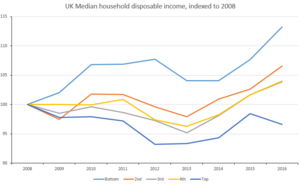
Back برنامج التقشف الحكومي في المملكة المتحدة Arabic United Kingdom government austerity programme SIMPLE

The United Kingdom government austerity programme is a fiscal policy that was adopted for a period in the early 21st century following the Great Recession. The term was used by the Coalition and Conservative governments in office from 2010 to 2019, and again during the 2021–present cost of living crisis. The two periods are separated by a stint of interventionist, Keynesian spending during the COVID-19 pandemic. The first period alone was “one of the biggest deficit reduction programmes seen in any advanced economy since World War II”, with the emphasis on shrinking the state rather than fiscal consolidation as was more common elsewhere in Europe.[2]
The Conservative-led government claimed that austerity served as a deficit reduction programme consisting of sustained reductions in public spending and tax rises, intended to reduce the government budget deficit and the role of the welfare state in the United Kingdom. Some commentators accepted this claim, but many scholars have observed that in fact its primary, largely unstated aim, like most austerity policies,[3] was to restore the rate of profit.[4][5] Successive Conservative governments claimed that the National Health Service[6] and education[7] had been "ringfenced" and protected from direct spending cuts,[8] but between 2010 and 2019 more than £30 billion in spending reductions were made to welfare payments, housing subsidies and social services.[9]
There was no central function or risk assessment made to predict the impact of austerity on services and budgets in the long term. There were however "big strategic moves" to protect groups more likely to vote Conservative, and make cuts elsewhere. This meant that the richest 20% of the population were largely protected, and the 2015 Conservative general election victory is credited to this tactic. During the second austerity period, a wider group than before were affected by the resulting cost-of-living crisis and this has been connected to declining support for the Conservatives.[10] The effects have proved controversial and the policies have received criticism from a variety of politicians, economists, and Anti-austerity movements.[2][11]
- ^ "Household disposable income and inequality in the UK: financial year ending 2016". Office for National Statistics. 10 January 2017.
- ^ a b Knight, Sam. "What Have Fourteen Years of Conservative Rule Done to Britain?".
- ^ "Austerity is not Working". UCL European Institute. London: University College London. 17 May 2012.
- ^ Etherington, David (2020). Austerity, Welfare and Work: Exploring Politics, Geographies and Inequalities. Bristol: Policy Press. pp. 28–41. ISBN 9781447350088.
- ^ Burke, Michael (13 October 2014). "There is a 'magic money tree' – it's investment". Policy Research in Macroeconomics. London: PRIME.
- ^ "NHS funding protected?". NHS Support Federation. Retrieved 19 May 2017.
- ^ "School spending stays protected from budget cuts". BBC News. 26 June 2013.
- ^ "Should NHS budget be ring-fenced?". BBC News. 1 May 2013. Retrieved 3 September 2016.
- ^ Cite error: The named reference
Muellerwas invoked but never defined (see the help page). - ^ Savage, Michael (16 March 2024). "'Negative budgets': cost of living crisis could lose the Tories dozens of seats". The Observer.
- ^ Krugman, Paul (29 April 2015). "The Austerity Delusion". The Guardian. Retrieved 2 May 2016.
© MMXXIII Rich X Search. We shall prevail. All rights reserved. Rich X Search